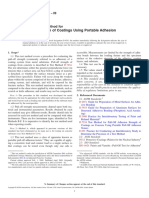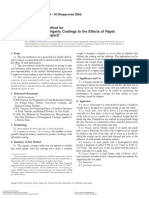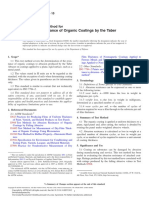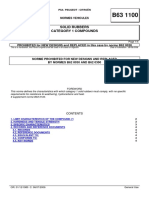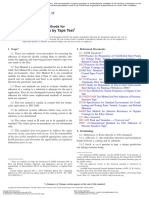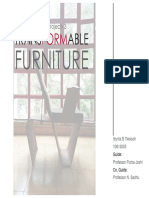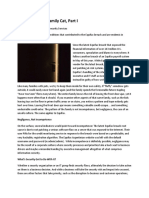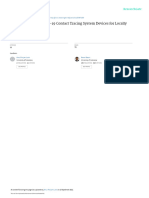ASTM-D-3359 Tape Adhesive Test
ASTM-D-3359 Tape Adhesive Test
Uploaded by
lakshmananCopyright:
Available Formats
ASTM-D-3359 Tape Adhesive Test
ASTM-D-3359 Tape Adhesive Test
Uploaded by
lakshmananCopyright
Available Formats
Share this document
Did you find this document useful?
Is this content inappropriate?
Copyright:
Available Formats
ASTM-D-3359 Tape Adhesive Test
ASTM-D-3359 Tape Adhesive Test
Uploaded by
lakshmananCopyright:
Available Formats
Designation: D3359 – 09´2
Standard Test Methods for
Measuring Adhesion by Tape Test1
This standard is issued under the fixed designation D3359; the number immediately following the designation indicates the year of
original adoption or, in the case of revision, the year of last revision. A number in parentheses indicates the year of last reapproval. A
superscript epsilon (´) indicates an editorial change since the last revision or reapproval.
This standard has been approved for use by agencies of the Department of Defense.
´1 NOTE—Footnote 5 and 5.2 were corrected editorially in June 2010.
´2 NOTE—Footnote 5 and 5.2 were corrected editorially and moved into Note 4 in 5.3 in July 2010.
1. Scope* 1.6 The values stated in SI units are to be regarded as the
1.1 These test methods cover procedures for assessing the standard. The values given in parentheses are for information
adhesion of coating films to metallic substrates by applying and only.
removing pressure-sensitive tape over cuts made in the film. 1.7 This standard does not purport to address the safety
concerns, if any, associated with its use. It is the responsibility
NOTE 1—This test method has been reported being used to measure of the user of this standard to establish appropriate safety and
adhesion of organic coatings on soft substrates (for example, wood and
health practices and determine the applicability of regulatory
plastic). Issues with plastic substrates are noted in Appendix X1. A similar
test method, ISO 2409, permits tests on soft substrates (for example, wood limitations prior to use.
and plaster). Precision and bias data on the later is lacking. Test Methods
D3359 was developed with metal as the substrate and, in the absence of 2. Referenced Documents
supporting precision and bias data, is so limited. 2.1 ASTM Standards:2
1.2 Test Method A is primarily intended for use at job sites D609 Practice for Preparation of Cold-Rolled Steel Panels
while Test Method B is more suitable for use in the laboratory. for Testing Paint, Varnish, Conversion Coatings, and
Also, Test Method B is not considered suitable for films thicker Related Coating Products
than 5 mils (125µm). D823 Practices for Producing Films of Uniform Thickness
of Paint, Varnish, and Related Products on Test Panels
NOTE 2—Subject to agreement between the purchaser and the seller, D1000 Test Methods for Pressure-Sensitive Adhesive-
Test Method B can be used for thicker films if wider spaced cuts are
Coated Tapes Used for Electrical and Electronic Applica-
employed.
tions
1.3 These test methods are used to establish whether the D1730 Practices for Preparation of Aluminum and
adhesion of a coating to a substrate is at a generally adequate Aluminum-Alloy Surfaces for Painting
level. They do not distinguish between higher levels of D2092 Guide for Preparation of Zinc-Coated (Galvanized)
adhesion for which more sophisticated methods of measure- Steel Surfaces for Painting3
ment are required. D2370 Test Method for Tensile Properties of Organic Coat-
NOTE 3—It should be recognized that differences in adherability of the ings
coating surface can affect the results obtained with coatings having the D3330/D3330M Test Method for Peel Adhesion of
same inherent adhesion. Pressure-Sensitive Tape
1.4 This test method is similar in content (but not techni- D3924 Specification for Environment for Conditioning and
cally equivalent) to ISO 2409. Testing Paint, Varnish, Lacquer, and Related Materials
1.5 In multicoat systems adhesion failure may occur be- D4060 Test Method for Abrasion Resistance of Organic
tween coats so that the adhesion of the coating system to the Coatings by the Taber Abraser
substrate is not determined.
1
These test methods are under the jurisdiction of ASTM Committee D01 on
2
Paint and Related Coatings, Materials, and Applications and are the direct For referenced ASTM standards, visit the ASTM website, www.astm.org, or
responsibility of Subcommittee D01.23 on Physical Properties of Applied Paint contact ASTM Customer Service at service@astm.org. For Annual Book of ASTM
Films. Standards volume information, refer to the standard’s Document Summary page on
Current edition approved June 1, 2009. Published June 2009. Originally the ASTM website.
3
approved in 1974. Last previous edition approved in 2008 as D3359 – 08. DOI: Withdrawn. The last approved version of this historical standard is referenced
10.1520/D3359-09E02. on www.astm.org.
--`,,`,,,,`,,,`,,`````,`````,,,-`-`,,`,,`,`,,`---
*A Summary of Changes section appears at the end of this standard.
Copyright © ASTM International, 100 Barr Harbor Drive, PO Box C700, West Conshohocken, PA 19428-2959, United States.
Copyright ASTM International
Provided by IHS under license with ASTM
1Sold to:NW PA Reg Plann and Dev Co, 689894
No reproduction or networking permitted without license from IHS Not for Resale,08/23/2011 11:20:37 MDT
D3359 – 09´2
2.2 Other Standard: comparable results to the Permacel P99 tape. If more information is
ISO 2409 Paint and Varnishes — Cross-cut test4 required about the tapes being evaluated in the D01.23 interlaboratory
study, please contact the Committee D01 staff manager.
3. Summary of Test Methods 5.4 Rubber Eraser, on the end of a pencil.
3.1 Test Method A—An X-cut is made through the film to 5.5 Illumination—A light source is helpful in determining
the substrate, pressure-sensitive tape is applied over the cut and whether the cuts have been made through the film to the
then removed, and adhesion is assessed qualitatively on the 0 substrate.
to 5 scale.
3.2 Test Method B—A lattice pattern with either six or 6. Test Specimens
eleven cuts in each direction is made in the film to the 6.1 When this test method is used in the field, the specimen
substrate, pressure-sensitive tape is applied over the lattice and is the coated structure or article on which the adhesion is to be
then removed, and adhesion is evaluated by comparison with evaluated.
descriptions and illustrations. 6.2 For laboratory use apply the materials to be tested to
4. Significance and Use panels of the composition and surface conditions on which it is
desired to determine the adhesion.
4.1 If a coating is to fulfill its function of protecting or
decorating a substrate, it must adhere to it for the expected NOTE 5—Applicable test panel description and surface preparation
service life. Because the substrate and its surface preparation methods are given in Practice D609 and Practices D1730 and D2092.
NOTE 6—Coatings should be applied in accordance with Practice D823,
(or lack of it) have a drastic effect on the adhesion of coatings,
or as agreed upon between the purchaser and the seller.
a method to evaluate adhesion of a coating to different NOTE 7—If desired or specified, the coated test panels may be subjected
substrates or surface treatments, or of different coatings to the to a preliminary exposure such as water immersion, salt spray, or high
same substrate and treatment, is of considerable usefulness in humidity before conducting the tape test. The conditions and time of
the industry. exposure will be governed by ultimate coating use or shall be agreed upon
4.2 The limitations of all adhesion methods and the specific between the purchaser and seller.
limitation of this test method to lower levels of adhesion (see
1.3) should be recognized before using it. The intra- and 7. Procedure
inter-laboratory precision of this test method is similar to other 7.1 Select an area free of blemishes and minor surface
widely-accepted tests for coated substrates (for example, Test imperfections. For tests in the field, ensure that the surface is
Method D2370 and Test Method D4060), but this is partly the clean and dry. Extremes in temperature or relative humidity
result of it being insensitive to all but large differences in may affect the adhesion of the tape or the coating.
adhesion. The limited scale of 0 to 5 was selected deliberately 7.1.1 For specimens which have been immersed: After
to avoid a false impression of being sensitive. immersion, clean and wipe the surface with an appropriate
solvent which will not harm the integrity of the coating. Then
TEST METHOD A—X-CUT TAPE TEST dry or prepare the surface, or both, as agreed upon between the
purchaser and the seller.
5. Apparatus and Materials 7.2 Make two cuts in the film each about 40 mm (1.5 in.)
5.1 Cutting Tool—Sharp razor blade, scalpel, knife or other long that intersect near their middle with a smaller angle of
cutting devices. It is of particular importance that the cutting between 30 and 45°. When making the incisions, use the
edges be in good condition. straightedge and cut through the coating to the substrate in one
5.2 Cutting Guide—Steel or other hard metal straightedge steady motion.
to ensure straight cuts. 7.3 Inspect the incisions for reflection of light from the
5.3 Tape—25-mm (1.0-in.) wide semitransparent pressure- metal substrate to establish that the coating film has been
sensitive tape with an adhesion strength agreed upon by the penetrated. If the substrate has not been reached make another
supplier and the user is needed. Because of the variability in X in a different location. Do not attempt to deepen a previous
adhesion strength from batch-to-batch and with time, it is cut as this may affect adhesion along the incision.
essential that tape from the same batch be used when tests are 7.4 At each day of testing, before initiation of testing,
to be run in different laboratories. If this is not possible the test remove two complete laps of the pressure-sensitive tape from
method should be used only for ranking a series of test the roll and discard. Remove an additional length at a steady
coatings. (that is, not jerked) rate and cut a piece about 75 mm (3 in.)
NOTE 4—Permacel P99 tape, previously identified as suitable for this long.
purpose, was withdrawn from manufacture in July 2009. Current supplies 7.5 Place the center of the tape at the intersection of the cuts
of Permacel 99 on the market at this time have a shelf life that runs out in with the tape running in the same direction as the smaller
July 2010. Subcommittee D01.23 is assessing alternative tapes and a new angles. Smooth the tape into place by finger in the area of the
interlaboratory study is planned to take place in 2010. Alternative tapes incisions and then rub firmly with the eraser on the end of a
with specifications similar to that of Permacel P99 tape are available. pencil. The color under the transparent tape is a useful
Users of alternative tapes should check whether the alternative tapes give
indication of when good contact has been made.
7.6 Within 90 6 30 s of application, remove the tape by
4
Available from American National Standards Institute (ANSI), 25 W. 43rd St., seizing the free end and pulling it off rapidly (not jerked) back
4th Floor, New York, NY 10036, http://www.ansi.org. upon itself at as close to an angle of 180° as possible.
--`,,`,,,,`,,,`,,`````,`````,,,-`-`,,`,,`,`,,`---
Copyright ASTM International
Provided by IHS under license with ASTM
2Sold to:NW PA Reg Plann and Dev Co, 689894
No reproduction or networking permitted without license from IHS Not for Resale,08/23/2011 11:20:37 MDT
D3359 – 09´2
7.7 Inspect the X-cut area for removal of coating from the TEST METHOD B—CROSS-CUT TAPE TEST
substrate or previous coating and rate the adhesion in accor-
dance with the following scale: 10. Apparatus and Materials
5A No peeling or removal,
4A Trace peeling or removal along incisions or at their intersection, 10.1 Cutting Tool 6—Sharp razor blade, scalpel, knife or
3A Jagged removal along incisions up to 1.6 mm (1⁄16 in.) on either side, other cutting device having a cutting edge angle between 15
2A Jagged removal along most of incisions up to 3.2 mm (1⁄8 in.) on either
side,
and 30° that will make either a single cut or several cuts at
1A Removal from most of the area of the X under the tape, and once. It is of particular importance that the cutting edge or
0A Removal beyond the area of the X. edges be in good condition.
7.8 Repeat the test in two other locations on each test panel. 10.2 Cutting Guide—If cuts are made manually (as opposed
For large structures make sufficient tests to ensure that the to a mechanical apparatus) a steel or other hard metal straight-
adhesion evaluation is representative of the whole surface. edge or template to ensure straight cuts.
7.9 After making several cuts examine the cutting edge and, 10.3 Rule—Tempered steel rule graduated in 0.5 mm for
if necessary, remove any flat spots or wire-edge by abrading measuring individual cuts.
lightly on a fine oil stone before using again. Discard cutting 10.4 Tape, as described in 5.3.
tools that develop nicks or other defects that tear the film.
10.5 Rubber Eraser, on the end of a pencil.
8. Report 10.6 Illumination, as described in 5.5.
10.7 Magnifying Glass—An illuminated magnifier to be
8.1 Report the number of tests, their mean and range, and
used while making individual cuts and examining the test area.
for coating systems, where the failure occurred that is, between
first coat and substrate, between first and second coat, etc.
11. Test Specimens
8.2 For field tests report the structure or article tested, the
location and the environmental conditions at the time of 11.1 Test specimens shall be as described in Section 6. It
testing. should be noted, however, that multitip cutters7 provide good
8.3 For test panels report the substrate employed, the type of results only on test areas sufficiently plane that all cutting edges
coating, the method of cure, and the environmental conditions contact the substrate to the same degree. Check for flatness
at the time of testing. with a straight edge such as that of the tempered steel rule
8.4 If the adhesion strength of the tape has been determined (10.3).
in accordance with Test Methods D1000 or D3330/D3330M,
report the results with the adhesion rating(s). If the adhesion 12. Procedure
strength of the tape has not been determined, report the specific 12.1 Where required or when agreed upon, subject the
tape used and its manufacturer. specimens to a preliminary test before conducting the tape test
8.5 If the test is performed after immersion, report immer- (see Note 5). After drying or testing the coating, conduct the
sion conditions and method of sample preparation. tape test at room temperature as defined in Specification
--`,,`,,,,`,,,`,,`````,`````,,,-`-`,,`,,`,`,,`---
D3924, unless D3924 standard temperature is required or
5
9. Precision and Bias agreed.
9.1 In an interlaboratory study of this test method in which 12.1.1 For specimens which have been immersed: After
operators in six laboratories made one adhesion measurement immersion, clean and wipe the surface with an appropriate
on three panels each of three coatings covering a wide range of solvent which will not harm the integrity of the coating. Then
adhesion, the within-laboratories standard deviation was found dry or prepare the surface, or both, as agreed upon between the
to be 0.33 and the between-laboratories 0.44. Based on these purchaser and the seller.
standard deviations, the following criteria should be used for 12.2 Select an area free of blemishes and minor surface
judging the acceptability of results at the 95 % confidence
imperfections, place on a firm base, and under the illuminated
level:
magnifier, make parallel cuts as follows:
9.1.1 Repeatability—Provided adhesion is uniform over a
12.2.1 For coatings having a dry film thickness up to and
large surface, results obtained by the same operator should be
considered suspect if they differ by more than 1 rating unit for including 2.0 mils (50 µm) space the cuts 1 mm apart and make
two measurements. eleven cuts unless otherwise agreed upon.
9.1.2 Reproducibility—Two results, each the mean of trip-
licates, obtained by different operators should be considered
suspect if they differ by more than 1.5 rating units. 6
Multiblade cutters are available from a few sources that specialize in testing
equipment for the paint industry.
9.2 Bias cannot be established for these test methods. 7
The sole source of supply of the multitip cutter for coated pipe surfaces known
to the committee at this time is Paul N. Gardner Co., 316 NE First St., Pompano
Beach, FL 33060. If you are aware of alternative suppliers, please provide this
information to ASTM International Headquarters. Your comments will receive
5
Supporting data have been filed at ASTM International Headquarters and may careful consideration at a meeting of the responsible technical committee,1 which
be obtained by requesting Research Report RR:D01-1008. you may attend.
Copyright ASTM International
Provided by IHS under license with ASTM
3Sold to:NW PA Reg Plann and Dev Co, 689894
No reproduction or networking permitted without license from IHS Not for Resale,08/23/2011 11:20:37 MDT
D3359 – 09´2
12.2.2 For coatings having a dry film thickness between 2.0
mils (50 µm) and 5 mils (125 µm), space the cuts 2 mm apart
and make six cuts. For films thicker than 5 mils (125 µm), use
Test Method A.8
12.2.3 Make all cuts about 20 mm (3⁄4 in.) long. Cut through
the film to the substrate in one steady motion using just
sufficient pressure on the cutting tool to have the cutting edge
reach the substrate. When making successive single cuts with
the aid of a guide, place the guide on the uncut area.
12.3 After making the required cuts brush the film lightly
with a soft brush or tissue to remove any detached flakes or
ribbons of coatings.
12.4 Examine the cutting edge and, if necessary, remove
any flat spots or wire-edge by abrading lightly on a fine oil
stone. Make the additional number of cuts at 90° to and
centered on the original cuts.
12.5 Brush the area as before and inspect the incisions for
reflection of light from the substrate. If the metal has not been
reached make another grid in a different location.
12.6 At each day of testing, before initiation of testing,
remove two complete laps of tape and discard. Remove an
additional length at a steady (that is, not jerked) rate and cut a
piece about 75 mm (3 in.) long.
--`,,`,,,,`,,,`,,`````,`````,,,-`-`,,`,,`,`,,`---
12.7 Place the center of the tape over the grid and in the area
of the grid smooth into place by a finger. To ensure good
contact with the film rub the tape firmly with the eraser on the
end of a pencil. The color under the tape is a useful indication
of when good contact has been made.
12.8 Within 90 6 30 s of application, remove the tape by
seizing the free end and rapidly (not jerked) back upon itself at
as close to an angle of 180° as possible.
12.9 Inspect the grid area for removal of coating from the
substrate or from a previous coating using the illuminated
magnifier. Rate the adhesion in accordance with the following FIG. 1 Classification of Adhesion Test Results
scale illustrated in Fig. 1:
5B The edges of the cuts are completely smooth; none of the squares of the 13.2 Report the substrate employed, the type of coating and
lattice is detached. the method of cure.
4B Small flakes of the coating are detached at intersections; less than 5 %
of the area is affected.
13.3 If the adhesion strength has been determined in accor-
3B Small flakes of the coating are detached along edges and at intersec- dance with Test Methods D1000 or D3330/D3330M, report the
tions of cuts. The area affected is 5 to 15 % of the lattice. results with the adhesion rating(s). If the adhesion strength of
2B The coating has flaked along the edges and on parts of the squares.
The area affected is 15 to 35 % of the lattice.
the tape has not been determined, report the specific tape used
1B The coating has flaked along the edges of cuts in large ribbons and and its manufacturer.
whole squares have detached. The area affected is 35 to 65 % of the 13.4 If the test is performed after immersion, report immer-
lattice.
0B Flaking and detachment worse than Grade 1.
sion conditions and method of sample preparation.
12.10 Repeat the test in two other locations on each test 14. Precision and Bias 5
panel. 14.1 On the basis of two interlaboratory tests of this test
method in one of which operators in six laboratories made one
13. Report adhesion measurement on three panels each of three coatings
13.1 Report the number of tests, their mean and range, and covering a wide range of adhesion and in the other operators in
for coating systems, where the failure occurred, that is, six laboratories made three measurements on two panels each
between first coat and substrate, between first and second coat, of four different coatings applied over two other coatings, the
etc. pooled standard deviations for within- and between-
laboratories were found to be 0.37 and 0.7. Based on these
standard deviations, the following criteria should be used for
8
judging the acceptability of results at the 95 % confidence
Test Method B has been used successfully by some people on coatings greater
than 5 mils (0.13 mm) by spacing the cuts 5 mm apart. However, the precision
level:
values given in 14.1 do not apply as they are based on coatings less than 5 mils (0.13 14.1.1 Repeatability—Provided adhesion is uniform over a
mm) in thickness. large surface, results obtained by the same operator should be
Copyright ASTM International
Provided by IHS under license with ASTM
4Sold to:NW PA Reg Plann and Dev Co, 689894
No reproduction or networking permitted without license from IHS Not for Resale,08/23/2011 11:20:37 MDT
D3359 – 09´2
considered suspect if they differ by more than one rating unit 14.2 Bias cannot be established for these test methods.
for two measurements.
14.1.2 Reproducibility—Two results, each the mean of du- 15. Keywords
plicates or triplicates, obtained by different operators should be 15.1 adhesion; crosscut adhesion test method; tape; tape
considered suspect if they differ by more than two rating units. adhesion test method; X-cut adhesion test method
APPENDIX
(Nonmandatory Information)
X1. COMMENTARY
X1.1 Introduction There generally is difficulty, however, in relating these tests to
X1.1.1 Given the complexities of the adhesion process, can basic adhesion phenomena.
adhesion be measured? As Mittal (1)9 has pointed out, the
answer is both yes and no. It is reasonable to state that at the X1.3 The Tape Test
present time no test exists that can precisely assess the actual X1.3.1 By far the most prevalent test for evaluating coating
physical strength of an adhesive bond. But it can also be said “adhesion” is the tape-and-peel test, which has been used since
that it is possible to obtain an indication of relative adhesion the 1930’s. In its simplest version a piece of adhesive tape is
performance. pressed against the paint film and the resistance to and degree
X1.1.2 Practical adhesion test methods are generally of two of film removal observed when the tape is pulled off. Since an
types: “implied” and “direct.” “Implied” tests include indenta- intact film with appreciable adhesion is frequently not removed
tion or scribe techniques, rub testing, and wear testing. Criti- at all, the severity of the test is usually enhanced by cutting into
cism of these tests arises when they are used to quantify the the film a figure X or a cross hatched pattern, before applying
strength of adhesive bonding. But this, in fact, is not their and removing the tape. Adhesion is then rated by comparing
purpose. An “implied” test should be used to assess coating film removed against an established rating scale. If an intact
performance under actual service conditions. “Direct” mea- film is peeled cleanly by the tape, or if it debonds just by
surements, on the other hand, are intended expressly to cutting into it without applying tape, then the adhesion is rated
measure adhesion. Meaningful tests of this type are highly simply as poor or very poor, a more precise evaluation of such
sought after, primarily because the results are expressed by a films not being within the capability of this test.
single discrete quantity, the force required to rupture the X1.3.2 The current widely-used version was first published
coating/substrate bond under prescribed conditions. Direct in 1974; two test methods are covered in this standard. Both
tests include the Hesiometer and the Adherometer (2). Com- test methods are used to establish whether the adhesion of a
mon methods which approach the direct tests are peel, lap- coating to a substrate is at an adequate level; however they do
shear, and tensile tests. not distinguish between higher levels of adhesion for which
more sophisticated methods of measurement are required.
X1.2 Test Methods Major limitations of the tape test are its low sensitivity,
X1.2.1 In practice, numerous types of tests have been used applicability only to coatings of relatively low bond strengths,
to attempt to evaluate adhesion by inducing bond rupture by and non-determination of adhesion to the substrate where
different modes. Criteria deemed essential for a test to warrant failure occurs within a single coat, as when testing primers
large-scale acceptance are: use of a straightforward and unam- alone, or within or between coats in multicoat systems. For
biguous procedure; relevance to its intended application; re- multicoat systems where adhesion failure may occur between
peatability and reproducibility; and quantifiability, including a or within coats, the adhesion of the coating system to the
meaningful rating scale for assessing performance. substrate is not determined.
X1.2.2 Test methods used for coatings on metals are: peel X1.3.3 Repeatability within one rating unit is generally
adhesion or “tape testing;” Gardner impact flexibility testing; observed for coatings on metals for both methods, with
and adhesive joint testing including shear (lap joint) and direct reproducibility of one to two units. The tape test enjoys
tensile (butt joint) testing. These tests do not strictly meet all widespread popularity and is viewed as “simple” as well as low
the criteria listed, but an appealing aspect of these tests is that in cost. Applied to metals, it is economical to perform, lends
in most cases the equipment/instrumentation is readily avail- itself to job site application, and most importantly, after
able or can be obtained at reasonable cost. decades of use, people feel comfortable with it.
X1.2.3 A wide diversity of tests methods have been devel- X1.3.4 When a flexible adhesive tape is applied to a coated
oped over the years that measure aspects of adhesion (1-5). rigid substrate surface and then removed, the removal process
has been described in terms of the “peel phenomenon,” as
illustrated in Fig. X1.1.
9
The boldface numbers in parentheses refer to the list of references at the end of X1.3.5 Peeling begins at the “toothed” leading edge (at the
this test method. right) and proceeds along the coating adhesive/interface or the
--`,,`,,,,`,,,`,,`````,`````,,,-`-`,,`,,`,`,,`---
Copyright ASTM International
Provided by IHS under license with ASTM
5Sold to:NW PA Reg Plann and Dev Co, 689894
No reproduction or networking permitted without license from IHS Not for Resale,08/23/2011 11:20:37 MDT
D3359 – 09´2
lead to different results as small changes in backing stiffness
and adhesive rheology cause large changes in the tension area.
Some commercial tapes are manufactured to meet minimum
standards. A given lot may surpass these standards and thus be
suitable for general market distribution; however, such a lot
may be a source of serious and unexpected error in assessing
adhesion. One commercially available tape test kit had in-
cluded a tape with adhesion strength variations of up to 50 %
claimed by the manufacturer. Also, because tapes change on
storage, bond strengths of the tape may change over time (7, 8).
X1.5.2 While there are tapes available that appear to deliver
consistent performance, a given tape does not adhere equally
well to all coatings. For example, when the peel removal force
of the tape (from the coating) used earlier by Task Group
D01.23.10 to establish precision of the method, by 3M No. 710
was examined with seven different electromagnetic
interference/radio frequency interference (EMI/RFI) coatings,
FIG. X1.1 Peel Profile (6) it was found that, while peel was indeed consistent for a given
coating, the value varied by 25 % between the highest and
lowest ratings among coatings. Several factors that contribute
coating/substrate interface, depending on the relative bond
to these differences include coating composition and topology:
strengths. It is assumed that coating removal occurs when the
as a result, no single tape is likely to be suitable for testing all
tensile force generated along the latter interface, which is a
coatings. Further, the tape test does not give an absolute value
function of the rheological properties of the backing and
for the force required for bond rupture, but serves only as an
adhesive layer materials, is greater than the bond strength at the
indicator that some minimum value for bond strength was met
coating-substrate interface (or cohesive strength of the coat-
or exceeded (7, 8).
ing). In actuality, however, this force is distributed over a
discrete distance (O-A) in Fig. X1.1, which relates directly to X1.6 Procedural Problems
the properties described, not concentrated at a point (O) in Fig. X1.6.1 The tape test is operator intensive. By design it was
X1.1 as in the theoretical case—though the tensile force is made as simple as possible to perform, and requires a mini-
greatest at the origin for both. A significant compressive force mum of specialized equipment and materials that must meet
arises from the response of the tape backing material to being certain specifications. The accuracy and precision depend
stretched. Thus both tensile and compressive forces are in- largely upon the skill of the operator and the operator’s ability
volved in adhesion tape testing. to perform the test in a consistent manner. Key steps that
X1.3.6 Close scrutiny of the tape test with respect to the directly reflect the importance of operator skill include the
nature of the tape employed and certain aspects of the angle and rate of tape removal and the visual assessment of the
procedure itself reveal several factors, each or any combination tested sample. It is not unexpected that different operators
of which can dramatically affect the results of the test as might obtain different results (7, 8).
discussed (6). X1.6.2 Peel Angle and Rate:
The standard requires that the free end of the tape be
X1.4 Peel Adhesion Testing on Plastic Substrates removed rapidly at as close to a 180° angle as possible. If the
X1.4.1 Tape tests have been criticized when used for peel angle and rate vary, the force required to remove the tape
substrates other than metal, such as plastics. The central issues can change dramatically. Nearly linear increases were observed
are that the test on plastics lacks reproducibility and does not in peel force approaching 100 % as peel angle was changed
relate to the intended application. Both concerns are well from 135 to 180, and similar large differences can be expected
founded: poor precision is a direct result of several factors in peel force as peel rate varies. These effects are related as
intrinsic to the materials employed and the procedure itself. they reflect certain rheological properties of the backing and
More importantly, in this instance the test is being applied adhesive that are molecular in origin. Variation in pull rate and
beyond its intended scope. These test methods were designed peel angle can effect large differences in test values and must
for relatively ductile coatings applied to metal substrates, not be minimized to assure reproducibility (9).
for coatings (often brittle) applied to plastic parts (7). The X1.6.3 Visual Assessment:
unique functional requirements of coatings on plastic sub- The final step in the test is visual assessment of the coating
strates cause the usual tape tests to be unsatisfactory for removed from the specimen, which is subjective in nature, so
measuring adhesion performance in practice. that the coatings can vary among individuals evaluating the
same specimen (9).
X1.5 The Tape Controversy X1.6.3.1 Performance in the tape test is based on the
X1.5.1 With the withdrawal from commerce of the tape amount of coating removed compared to a descriptive scale.
specified originally, 3M No. 710, current test methods no The exposure of the substrate can be due to factors other than
longer identify a specific tape. Differences in tapes used can coating adhesion, including that arising from the requirement
--`,,`,,,,`,,,`,,`````,`````,,,-`-`,,`,,`,`,,`---
Copyright ASTM International
Provided by IHS under license with ASTM
6Sold to:NW PA Reg Plann and Dev Co, 689894
No reproduction or networking permitted without license from IHS Not for Resale,08/23/2011 11:20:37 MDT
D3359 – 09´2
that the coating be cut (hence the synonym“ cross-hatch X1.6.5 Test Method B has been used successfully, without
adhesion test”). Justification for the cutting step is reasonable affecting adhesion test results, by some coil coating users on
as cutting provides a free edge from which peeling can begin coatings up to and including 2.0 mils (50 µm) by spacing the
without having to overcome the cohesive strength of the cuts 2 mm apart. While this may be an agreement between
coating layer. purchaser and seller, the precision values given in 14.1 do no
X1.6.3.2 Cutting might be suitable for coatings applied to apply, as they are based on cuts 1 mm apart.
metal substrates, but for coatings applied to plastics or wood, X1.6.6 Some have found that the use of a suitable mechani-
the process can lead to a misleading indication of poor cal device is helpful in minimizing some of the variables in
adhesion due to the unique interfacial zone. For coatings on placing the tape onto the coatings (see 7.5 and 12.7) and
soft substrates, issues include how deep should this cut removing the tape from the coatings (see 7.6 and 12.8) which
penetrate, and is it possible to cut only to the interface? maintains consistent pressure on the tape during application
X1.6.3.3 In general, if adhesion test panels are examined and ensures a 180° pull off.10
microscopically, it is often clearly evident that the coating
removal results from substrate failure at or below the interface, X1.7 Conclusion
and not from the adhesive failure between the coating and the X1.7.1 All the issues aside, if these test methods are used
substrate. Cohesive failure within the coating film is also within the Scope Section and are performed carefully, some
frequently observed. However, with the tape test, failures insight into the approximate, relative level of adhesion can be
within the substrate or coating layers are rare because the tape gained.
adhesive is not usually strong enough to exceed the cohesive
strengths of normal substrates and organic coatings. Although
some rather brittle coatings may exhibit cohesive failure, the 10
The sole source of supply of a suitable mechanical device for laying down and
tape test adhesion method does not make provision for giving removal of tape known to the committee at this time is ReliaPull, a registered
failure locality (7, 8). trademark of Random Logic LLC, manufactured by Random Logic LLC, Cincin-
nati, OH 45245. If you are aware of alternative suppliers, please provide this
X1.6.4 Use of the test method in the field can lead to
information to ASTM International Headquarters. Your comments will receive
variation in test results due to temperature and humidity careful consideration at a meeting of the responsible technical committee,1 which
changes and their effect upon tape, coating and substrate. you may attend.
REFERENCES
--`,,`,,,,`,,,`,,`````,`````,,,-`-`,,`,,`,`,,`---
(1) Mittal, K. L., “Adhesion Measurement: Recent Progress, Unsolved (6) Souheng, Wu, Polymer Interface and Adhesion, Marcel Dekker, Inc.,
Problems, and Prospects,” Adhesion Measurement of Thin Films, New York, NY, 1982, p. 531.
Thick Films, and Bulk Coatings, ASTM STP 640, ASTM, 1978, pp. (7) Nelson, G. L., Gray, K. N., and Buckley, S. E., Modern Paint and
7–8. Coatings, Vol 75, No. 10, 1985, pp. 160–172.
(2) Corcoron, E. M., “Adhesion,” Chapter 5.3, Paint Testing Manual, 13th
ed., ASTM STP 500, ASTM, 1972, pp. 314–332. (8) Nelson, G. L., and Gray, K. N., “Coating Adhesion to Plastics,”
(3) Gardner, H. A., and Sward, G. G., Paint Testing Manual, 12th ed., Proceedings, Waterborne and Higher Solids Coatings Symposium,
Chapter 7, Gardner Laboratory, Bethesda, MD, 1962, pp. 159–170. Vol 13, New Orleans, LA, February 5–7, 1986, pp. 114–131.
(4) Mittal, K. L., Journal of Adhesion Science and Technology, Vol 1, No. (9) K. L. Mittal, ed., “Symposium on Adhesion Aspects of Polymeric
3, 1987, pp. 247–259. Coatings,” Proceedings, The Electrochemical Society, 1981, pp.
(5) Stoffer, J. O., and Gadodia, S. K., American Paint and Coatings 569–582.
Journal, Vol 70, Nos. 50 and 51, 1991, pp. 36–40 and 36–51,
respectively.
SUMMARY OF CHANGES
Committee D01 has identified the location of selected changes to this standard since the last issue (D3359 - 08)
that may impact the use of this standard. (Approved June 1, 2009.)
(1) X1.6.6 was added to Appendix X1. (2) Footnote 11 was added to identify a source of equipment.
Committee D01 has identified the location of selected changes to this standard since the last issue (D3359 - 07)
that may impact the use of this standard. (Approved February 1, 2008.)
(1) X1.6.5 was added to Appendix X1.
Copyright ASTM International
Provided by IHS under license with ASTM
7Sold to:NW PA Reg Plann and Dev Co, 689894
No reproduction or networking permitted without license from IHS Not for Resale,08/23/2011 11:20:37 MDT
D3359 – 09´2
ASTM International takes no position respecting the validity of any patent rights asserted in connection with any item mentioned
in this standard. Users of this standard are expressly advised that determination of the validity of any such patent rights, and the risk
of infringement of such rights, are entirely their own responsibility.
This standard is subject to revision at any time by the responsible technical committee and must be reviewed every five years and
if not revised, either reapproved or withdrawn. Your comments are invited either for revision of this standard or for additional standards
and should be addressed to ASTM International Headquarters. Your comments will receive careful consideration at a meeting of the
responsible technical committee, which you may attend. If you feel that your comments have not received a fair hearing you should
make your views known to the ASTM Committee on Standards, at the address shown below.
This standard is copyrighted by ASTM International, 100 Barr Harbor Drive, PO Box C700, West Conshohocken, PA 19428-2959,
United States. Individual reprints (single or multiple copies) of this standard may be obtained by contacting ASTM at the above
address or at 610-832-9585 (phone), 610-832-9555 (fax), or service@astm.org (e-mail); or through the ASTM website
(www.astm.org). Permission rights to photocopy the standard may also be secured from the ASTM website (www.astm.org/
COPYRIGHT/).
--`,,`,,,,`,,,`,,`````,`````,,,-`-`,,`,,`,`,,`---
Copyright ASTM International
Provided by IHS under license with ASTM
8Sold to:NW PA Reg Plann and Dev Co, 689894
No reproduction or networking permitted without license from IHS Not for Resale,08/23/2011 11:20:37 MDT
You might also like
- Astm D3359-23Document9 pagesAstm D3359-23jesus.cwiengineerNo ratings yet
- Astm D3363 PDFDocument2 pagesAstm D3363 PDFktloro91% (11)
- ASTM D5420-04 - Gardner - Impact Resistance of Flat Rigid Plastic Specimen PDFDocument8 pagesASTM D5420-04 - Gardner - Impact Resistance of Flat Rigid Plastic Specimen PDFMehdi Gouader0% (1)
- Harmonized Document: Fluids Resistance To VariousDocument8 pagesHarmonized Document: Fluids Resistance To VariousJuliano Depetris100% (1)
- Mass FinishingDocument544 pagesMass FinishingElías Tamez100% (1)
- Evaluation of Scratch Resistance of Polymeric Coatings and Plastics Using An Instrumented Scratch MachineDocument9 pagesEvaluation of Scratch Resistance of Polymeric Coatings and Plastics Using An Instrumented Scratch MachineMarly Blanco VeraNo ratings yet
- Astm D1735-21Document3 pagesAstm D1735-21bdr85No ratings yet
- ASTM D5895 - 2020 Drying TimeDocument4 pagesASTM D5895 - 2020 Drying TimePablo OrtegaNo ratings yet
- Astm D 1730 03Document3 pagesAstm D 1730 03Tharra Ayuriany67% (3)
- Astm D5402Document3 pagesAstm D5402Shreya Upadhyaya100% (3)
- Astm D 4541-09Document16 pagesAstm D 4541-09Duongthithuydung100% (1)
- GMW14872 - Cyclic Corrosion Laboratory TestDocument22 pagesGMW14872 - Cyclic Corrosion Laboratory TestZAPSENo ratings yet
- Astm D2794-93 PDFDocument3 pagesAstm D2794-93 PDFAllan Lindo100% (1)
- ASTM For Primer Coating TestingDocument4 pagesASTM For Primer Coating TestingMuhammad Umer Draz100% (1)
- Astm D3170 Chipping Resistance GravelometerDocument7 pagesAstm D3170 Chipping Resistance Gravelometermarikyababu13365No ratings yet
- Astm D 816Document6 pagesAstm D 816casilvaNo ratings yet
- Testing Water Resistance of Coatings Using Controlled CondensationDocument4 pagesTesting Water Resistance of Coatings Using Controlled CondensationErin JohnsonNo ratings yet
- Evaluating Degree of Flaking (Scaling) of Exterior Paints: Standard Test Method ForDocument4 pagesEvaluating Degree of Flaking (Scaling) of Exterior Paints: Standard Test Method ForSudharsanNo ratings yet
- ASTM D5402-93 - Assessing Solvent Resistance of Coatings Using Solvent Rub.Document2 pagesASTM D5402-93 - Assessing Solvent Resistance of Coatings Using Solvent Rub.Hoang Tuan Kiet100% (1)
- Pull-Off Strength of Coatings Using Portable Adhesion TestersDocument16 pagesPull-Off Strength of Coatings Using Portable Adhesion TestersKok Keong TanNo ratings yet
- Astm D4060-10Document5 pagesAstm D4060-10tkNo ratings yet
- D4585 PDFDocument3 pagesD4585 PDFten100% (1)
- ISO 8510-2 - Adhesives Peel Test For A Flexible-Bonded-To-Rigid Test Specimen Assembly 180° Peel 12-1-2006Document12 pagesISO 8510-2 - Adhesives Peel Test For A Flexible-Bonded-To-Rigid Test Specimen Assembly 180° Peel 12-1-2006axeldanyNo ratings yet
- Standard Test Method For Impact Resistance D2794Document3 pagesStandard Test Method For Impact Resistance D2794vasu_suva100% (1)
- Astm 1735Document3 pagesAstm 1735jchemNo ratings yet
- Minimum Performance Requirements For Decorative Chromium Plated Plastic PartsDocument20 pagesMinimum Performance Requirements For Decorative Chromium Plated Plastic PartsJefferson CruzNo ratings yet
- D 3170 - 01 - RdmxnzatmdeDocument10 pagesD 3170 - 01 - RdmxnzatmdeEmre DalgicNo ratings yet
- Cleaning Metals Prior To Electroplating: Standard Guide ForDocument9 pagesCleaning Metals Prior To Electroplating: Standard Guide Forvuqar0979No ratings yet
- D4060-14 Standard Test Method For Abrasion Resistance of Organic Coatings by The Taber AbraserDocument5 pagesD4060-14 Standard Test Method For Abrasion Resistance of Organic Coatings by The Taber AbraserMaria Fernanda Carrasco IdrovoNo ratings yet
- ISO - 11998 - Wet Scub Resistance and CleanabilityDocument6 pagesISO - 11998 - Wet Scub Resistance and Cleanabilityichsan hakim100% (2)
- Astm D 3363-05Document3 pagesAstm D 3363-05briham100% (3)
- Astm D 1002Document5 pagesAstm D 1002Aisya IbrahimNo ratings yet
- NYPC Leveling Test BladeDocument1 pageNYPC Leveling Test BladecaronieblesNo ratings yet
- Conducting Exterior Exposure Tests of Paints and Coatings On Metal SubstratesDocument5 pagesConducting Exterior Exposure Tests of Paints and Coatings On Metal SubstratesKedar BhaveNo ratings yet
- Micrometer Bend Test For Ductility of ElectrodepositsDocument2 pagesMicrometer Bend Test For Ductility of ElectrodepositsJohnny100% (1)
- Astm D-5324 - 1998 PDFDocument12 pagesAstm D-5324 - 1998 PDFdeepan govindasamy100% (1)
- Astm D 523 BrilloDocument5 pagesAstm D 523 BrillodesarrolloNo ratings yet
- Determining Volatile Organic Compound (VOC) Content of Paints and Related CoatingsDocument6 pagesDetermining Volatile Organic Compound (VOC) Content of Paints and Related Coatingsvituruch100% (1)
- Astmd2244 23Document12 pagesAstmd2244 23Tatiana ViannaNo ratings yet
- Astm D 562-01 Standard Test Method For Consistency of Paints Measuring Krebs Unit Viscosity Using A StormerDocument6 pagesAstm D 562-01 Standard Test Method For Consistency of Paints Measuring Krebs Unit Viscosity Using A StormerGianinaRoncalChávez33% (3)
- Immersion Testing of Industrial Protective Coatings: Standard Practice ForDocument6 pagesImmersion Testing of Industrial Protective Coatings: Standard Practice ForJhon Jeiwer SantosNo ratings yet
- 3 6077 RTVDocument2 pages3 6077 RTVgkretroNo ratings yet
- Astm E96-96m 2014Document13 pagesAstm E96-96m 2014tsalemnoushNo ratings yet
- ASTEM D955 00 - Standard Test Method of Measuring Shrinkage From Mold Dimensions of Thermoplastics PDFDocument5 pagesASTEM D955 00 - Standard Test Method of Measuring Shrinkage From Mold Dimensions of Thermoplastics PDFAndre Rodriguez Spirim100% (1)
- Film Hardness by Pencil Test: Standard Test Method ForDocument3 pagesFilm Hardness by Pencil Test: Standard Test Method ForNameNo ratings yet
- B63 1100 (Rev. C 2006.07) EN - SOLID RUBBERS CATEGORY 1 COMPOUNDSDocument4 pagesB63 1100 (Rev. C 2006.07) EN - SOLID RUBBERS CATEGORY 1 COMPOUNDSDiego Camargo100% (1)
- 2 Astm D6943Document16 pages2 Astm D6943Boris CardenasNo ratings yet
- Astm D 4060Document3 pagesAstm D 4060Arab WeldersNo ratings yet
- ASTM D3013 Epoxy Molding CompoundsDocument3 pagesASTM D3013 Epoxy Molding CompoundsNelson RomeroNo ratings yet
- D 3164 - 03 - RDMXNJQ - PDFDocument4 pagesD 3164 - 03 - RDMXNJQ - PDFJOHNNo ratings yet
- Sspc-Pa 16-2012 PDFDocument2 pagesSspc-Pa 16-2012 PDFRaul Sebastiam100% (2)
- Norma Astm D-4541Document16 pagesNorma Astm D-4541Miguel RojasNo ratings yet
- D5162 15 PDFDocument5 pagesD5162 15 PDFSuperCow FelizNo ratings yet
- Rating Adhesion by Tape Test: Standard Test Methods ForDocument9 pagesRating Adhesion by Tape Test: Standard Test Methods ForArjun MVNo ratings yet
- Measuring Adhesion by Tape Test: Standard Test Methods ForDocument7 pagesMeasuring Adhesion by Tape Test: Standard Test Methods ForJony NavaNo ratings yet
- Standard Test Methods For Measuring Adhesion by Tape Test 1: July 2019Document9 pagesStandard Test Methods For Measuring Adhesion by Tape Test 1: July 2019Axelo BackmixNo ratings yet
- Astm D3359Document9 pagesAstm D3359TEJAS GADKARINo ratings yet
- Flexible Glass: Enabling Thin, Lightweight, and Flexible ElectronicsFrom EverandFlexible Glass: Enabling Thin, Lightweight, and Flexible ElectronicsSean M. GarnerNo ratings yet
- Rubber Nanocomposites: Preparation, Properties, and ApplicationsFrom EverandRubber Nanocomposites: Preparation, Properties, and ApplicationsNo ratings yet
- Periodontology 2000 - 2023 - Jepsen - Complications and Treatment Errors Involving Periodontal Tissues Related ToDocument24 pagesPeriodontology 2000 - 2023 - Jepsen - Complications and Treatment Errors Involving Periodontal Tissues Related TopaolaNo ratings yet
- Integrated Solutionsthriving PDFDocument20 pagesIntegrated Solutionsthriving PDFJorge RodriguezNo ratings yet
- Impact of Hydrogenous Gas Injection On The Blast Furnace Process: A Numerical InvestigationDocument22 pagesImpact of Hydrogenous Gas Injection On The Blast Furnace Process: A Numerical Investigationpaulohmodesto1981No ratings yet
- Numismatics - An Art and Investment.Document4 pagesNumismatics - An Art and Investment.Suresh Kumar manoharanNo ratings yet
- TOPIC 2 - Classification of CompanyDocument24 pagesTOPIC 2 - Classification of CompanyShahrizatSmailKassimNo ratings yet
- Transformable Furniture (Presentation) Author Ibynta B TiewsohDocument48 pagesTransformable Furniture (Presentation) Author Ibynta B TiewsohadminNo ratings yet
- Equifax Breach PartIDocument4 pagesEquifax Breach PartIkesreschNo ratings yet
- Panasonic EW1211 Manual Version EUDocument108 pagesPanasonic EW1211 Manual Version EUEdwardMunroTuddyNo ratings yet
- Papers 24Document4 pagesPapers 24tyagim674674No ratings yet
- Proximity-Based COVID-19 Contact Tracing System Devices For Locally Problems SolutionDocument7 pagesProximity-Based COVID-19 Contact Tracing System Devices For Locally Problems Solutionkashyapkartik152No ratings yet
- HST TrainingDocument11 pagesHST TrainingRamesh BabuNo ratings yet
- Knowledge Management in The Automobile Industry - FinalDocument13 pagesKnowledge Management in The Automobile Industry - FinalAshrafAbdoSNo ratings yet
- Communication Scope of Work BI-10-01483-0002Document18 pagesCommunication Scope of Work BI-10-01483-0002Afareen KhanNo ratings yet
- Entrance Exam Question PaperDocument4 pagesEntrance Exam Question PaperJanhvi Kishori ThakkarNo ratings yet
- A World of Region l5Document30 pagesA World of Region l5Kent Aron Lazona DoromalNo ratings yet
- Operation/Technical ManualDocument64 pagesOperation/Technical ManualBilal AloulouNo ratings yet
- List of State and Union Territory Capitals in IndiaDocument67 pagesList of State and Union Territory Capitals in Indiaanon_8049111No ratings yet
- f5 2010 Jun Q PDFDocument8 pagesf5 2010 Jun Q PDFcatcat1122No ratings yet
- HT Ancamine 2143Document6 pagesHT Ancamine 2143rosarioNo ratings yet
- PIP ARC01016 Building Data SheetDocument13 pagesPIP ARC01016 Building Data Sheetivanov5559No ratings yet
- Stress Management TechniquesDocument4 pagesStress Management TechniquesMuhammad Hashim MemonNo ratings yet
- Islamic Wealth Management PDFDocument10 pagesIslamic Wealth Management PDFislamicthinkerNo ratings yet
- List of FormatsDocument93 pagesList of FormatsBscpl Repalle to EeppurpalemNo ratings yet
- Checklist For GRS - RCS GOTS - OCS CertificationDocument8 pagesChecklist For GRS - RCS GOTS - OCS Certificationm f velatiNo ratings yet
- Designing and Analysing Stair Case Lift SystemDocument8 pagesDesigning and Analysing Stair Case Lift System049Pavan MNo ratings yet
- Tirol, Courtney Allison P. Topic: Ultra Vires Acts of A Corporation 14-0707 #78Document2 pagesTirol, Courtney Allison P. Topic: Ultra Vires Acts of A Corporation 14-0707 #78Courtney TirolNo ratings yet
- Open Mapping Theorem (Complex Analysis) PDFDocument2 pagesOpen Mapping Theorem (Complex Analysis) PDFCory BlackwellNo ratings yet
- Proposal MTG E-Commerce WebDocument9 pagesProposal MTG E-Commerce WeblokalalithaambikayantrasNo ratings yet
- Machine Learning Based Spam E-Mail DetectionDocument10 pagesMachine Learning Based Spam E-Mail Detectionghazy almutiryNo ratings yet










